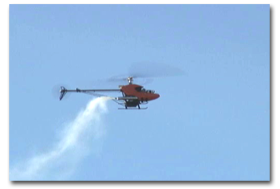 Snowflake is a collaboration between Naval Postgraduate School and University of Alabama at Huntsville to develop single and multiple autonomously guided parafoils. The project, described in detail here, uses an Arcturus T-20 UAV to launch the parafoils and a Surveyor SVS-based robot with Inertia Labs Renegade base to autonomously locate the parafoils after landing.
Snowflake is a collaboration between Naval Postgraduate School and University of Alabama at Huntsville to develop single and multiple autonomously guided parafoils. The project, described in detail here, uses an Arcturus T-20 UAV to launch the parafoils and a Surveyor SVS-based robot with Inertia Labs Renegade base to autonomously locate the parafoils after landing.We had the opportunity last week to view Snowflake field tests at CIRPAS McMillan Airfield. The Arcturus launched a pair of Snowflake parafoils from 3500-ft, and upon touchdown, the Snowflake controller transmitted GPS coordinates that were relayed to the robot. The robot then autonomously moved to the transmitted coordinates using a script written in picoC. We witnessed 3 successful UAV launch and robot retrieval cycles. Future tests will include drop of a smaller version of the Surveyor robot by parafoil.

Arcturus ready to launch. Note underwing pod carrying the parafoil.

Parafoil approaching the ground

Robot receives parafoil GPS coordinates

Robot driving through the grass to reach parafoil

Arcturus approaching touchdown




 This is quite a story -
This is quite a story - . Here is a short 3d stereo video clip captured from the blimp ...
. Here is a short 3d stereo video clip captured from the blimp ... From
From 